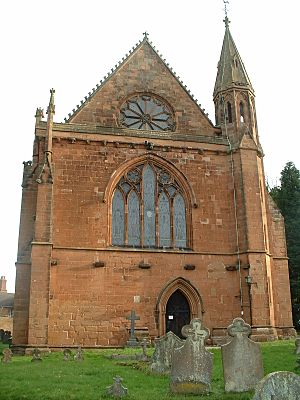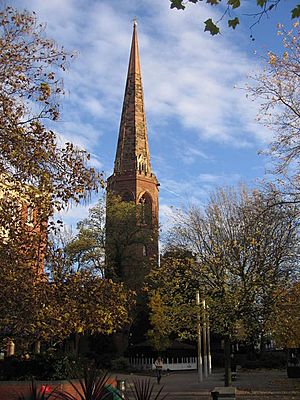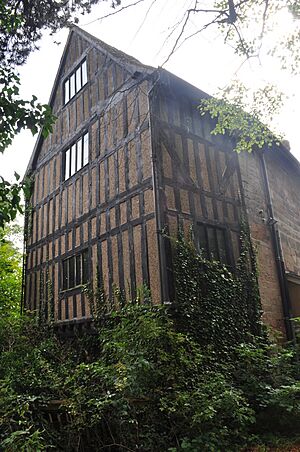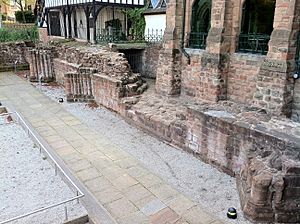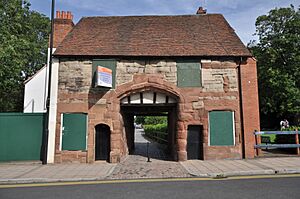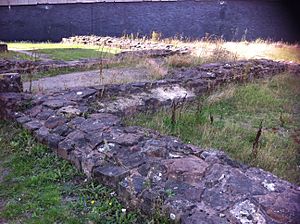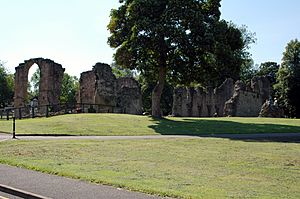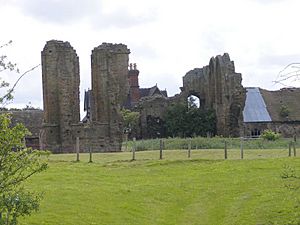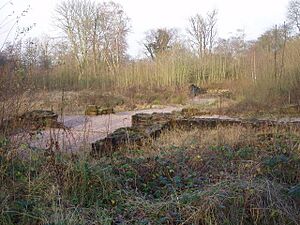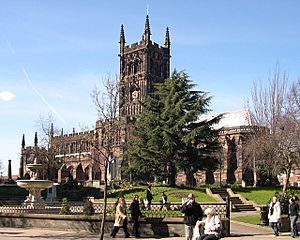List of monastic houses in the West Midlands (county) facts for kids
Have you ever wondered about ancient buildings where monks and nuns lived, prayed, and worked? These places are called monastic houses. The West Midlands region in England was once home to many such houses. They played a big part in history, from teaching and farming to helping the poor.
This article lists the main monastic houses that existed in the West Midlands. You'll learn about who lived there, when they were built, and what happened to them.
Alien houses are included, as are smaller establishments such as cells and notable monastic granges (particularly those with resident monks), and also camerae of the military orders of monks (Knights Templars and Knights Hospitaller). Monastic hospitals are included where they had the status or function of an abbey, priory, friary or preceptor/commandery.
- Abbreviations and key
| Symbol | Status |
|---|---|
| None | Ruins |
| * | Current monastic function |
| + | Current non-monastic ecclesiastic function (including remains incorporated into later structure) |
| ^ | Current non-ecclesiastic function (including remains incorporated into later structure) or redundant intact structure |
| $ | Remains limited to earthworks etc. |
| # | No identifiable trace of the monastic foundation remains |
| ~ | Exact site of monastic foundation unknown |
| ≈ | Identification ambiguous or confused |
Locations with names in italics indicate possible duplication (misidentification with another location) or non-existent foundations (either erroneous reference or proposed foundation never implemented) or ecclesiastical establishments with a monastic name but lacking actual monastic connection.
| EH | English Heritage |
| LT | Landmark Trust |
| NT | National Trust |
Contents
Monastic Houses in the West Midlands
Balsall Preceptory
This was a special kind of monastic house for the Knights Templar. They were a military-religious group. It was founded around 1146 by Roger Mowbray. It became a "preceptory" (a Templar base) before 1226.
The Knights Templar group was dissolved between 1308 and 1312. Later, in 1322, the site was given to the Knights Hospitaller, another military-religious order. The preceptory was dissolved again in 1470.
The building became very old and ruined. It was restored in 1622 and used as a chapel. Today, the church is still in use and is looked after by a special foundation.
Coventry Greyfriars
This house was home to Franciscan Friars Minor, Conventual, also known as Greyfriars because of their grey robes. It was founded before 1234 by Ralph, Earl of Chester.
Like many other monastic houses, it was dissolved on October 5, 1538. The land was then given to the Mayor and officials of Coventry in 1542 or 1543.
Coventry — St Anne's Priory
This priory was home to Carthusian monks. They were known for their very strict and quiet way of life. Monks came from other Carthusian houses like London Charterhouse.
It was founded in 1381 by William, Lord Zouch. The priory was dissolved on January 16, 1539. The land was later given to Richard Andrews and Leonard Chamberlain in 1542 or 1543.
Coventry — St Mary's Priory
There might have been a Saxon nunnery here before, which was destroyed by Danish raids in 1016. This priory was then founded for Benedictine monks around 1043. It was started by Leofric, Earl of Mercia, and his famous wife, Lady Godiva.
In 1102, it became a cathedral priory. This meant it was both a monastery and the main church for the bishop. It was dissolved on January 15, 1539. The bishop's main church then moved to Lichfield.
Coventry Whitefriars
This house was for Carmelite Friars, also called Whitefriars because of their white cloaks. A friary was first suggested here in 1287 but was not allowed.
It was finally founded in 1342 by Sir John Poultney, a wealthy citizen of London. The friary was dissolved on October 1, 1538. The land was given to Ralph Sadler in 1544 or 1545.
Dudley Priory
This priory was home to Cluniac monks. It was founded between 1149 and 1160 by Gervase Pagnell. He was carrying out the wishes of his father, Ralph.
Initially, it was dependent on another priory, Wenlock Priory. But from 1395, it became independent. The priory was dissolved in 1539. The site was given to Sir John Dudley in 1540 or 1541. Today, the remains are in a public park called Priory Park.
Halesowen Abbey
This abbey was for Premonstratensian Canons. They were a group of priests who lived together like monks. They came from Welbeck Abbey.
It was founded in 1218 by Peter des Roches, who was the Bishop of Winchester. King John had given the land for the abbey in 1214. The canons arrived in 1218. The abbey was dissolved on June 9, 1538. Parts of the old abbey church are now used as a barn on a farm.
Henwood Priory
This priory was for Benedictine nuns. It was founded between 1154 and 1159 by Ketelberne de Langdon.
The priory was dissolved in 1536. The land was then given to John Higford in 1539 or 1540.
Sandwell Priory
Before the priory, there was a hermitage here before 1180. The priory itself was founded for Benedictine monks around 1190. It was started by William, son of Guy de Offney.
The priory was dissolved in 1524 or 1525.
Wolverhampton Carmelite Monastery
This is a modern monastery for Carmelite nuns. Unlike the other houses listed, this one is still active today.
Wolverhampton Monastery
This site is believed to have been founded for Saxon monks around 659. It was traditionally started by Wulfhere, King of Mercia. It might have been re-established around 994 by Lady Wulfran.
Later, it became a "secular collegiate" church. This means it was a church with a group of clergy (priests) living together, but they weren't monks. It was dissolved in 1538. The church was restored between 1852 and 1865 and is still an important building today.
See also


